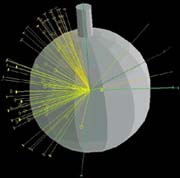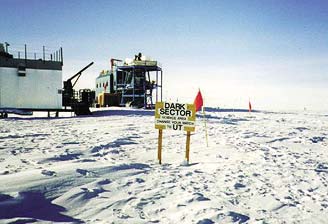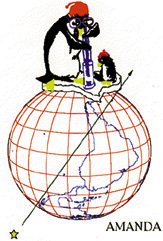 |
| SNO SEES FIRST LIGHT
On April 29, when the sphere had been filled with heavy water and the surrounding cavern with ordinary water, and when all 9,600 photomultiplier tubes were ready to look for Cerenkov radiation, SNO finally saw "first light"-the term used when telescopes and particle detectors begin gathering data.
Whenever 30 or more photomultipliers see a photon of Cerenkov light simultaneously, SNO records the event. It will be some time before researchers finish their tweaking to establish precise background levels for cosmic ray fragments and nearby radioactive decays. Still, allowing for some uncertainty, solar neutrino candidates have been arriving at a rate consistent with the 10 to 20 per day SNO was designed to see.
For computer-generated pictures of two of these visit SNO on the web. |
|
 |
Berkeley Lab researchers participate in many different neutrino experiments around the world and play leading roles in some, including the Sudbury Neutrino Observatory (SNO) in Ontario, Canada, and the Antarctic Muon and Neutrino Detector Array (AMANDA) at the Amundsen-Scott South Pole Station.
SNO, a collaboration among Canadian, American, and British universities and three Department of Energy national labs, is located 6,800 feet below the surface of the ground in a working nickel mine. The heart of the SNO neutrino detector is a 12-meter acrylic sphere containing 1,000 metric tons of heavy water, suspended inside a cavern 30 meters high filled with ordinary water. (In a heavy-water molecule there are two atoms of deuterium having a proton and a neutron in their nuclei, instead of ordinary, single-proton hydrogen nuclei.)
Ten thousand photomultiplier tubes peer into the heavy water, watching for faint flashes of blue light known as Cerenkov radiation, emitted whenever a particle passes at faster than the speed of light in water. The energy of the incoming particle and the direction from which it entered can be reconstructed from the brightness of the streak and the time of detection at different points on the sphere.
Many particles can make such tracks. SNO looks for those made by electrons and other particles produced when neutrinos interact with deuterium or when electrons are scattered directly by neutrinos-events that happen only 10 or 20 times a day.
"We're using over a mile of rock to filter out cosmic rays," says Eric Norman of the Nuclear Science Division and a member of the SNO collaboration, "but a few still get through-maybe 20 muons a day, produced by cosmic rays." They can be distinguished from neutrino events because they are highly energetic, and "an incoming muon will produce light all the way down, both inside and outside the sphere of heavy water."
The relatively low-energy neutrinos that SNO is primarily looking for are made in the sun, which pumps them out at the rate of two hundred trillion trillion trillion a second. "Supposedly the sun only produces electron-type neutrinos," Norman says, "but only a fraction of the expected number reaches Earth. Since there are three 'flavors' of neutrino in nature-electron-type, muon-type and tau-type-the solution to the solar neutrino puzzle may be that we see fewer than we'd expect because some of them have changed into other flavors by the time they get here-they 'oscillate.' SNO will be able to tell if that has happened."
There may even be a fourth flavor, the so-called "sterile" neutrino, which doesn't even feel the weak force. While such a particle could explain the solar-neutrino puzzle, its existence is controversial.
In SNO, an electron-type neutrino hitting a deuterium nucleus will produce two protons and an energetic electron, which produces Cerenkov radiation in the heavy water. Because the neutrino is converted into an electron in the process, this is called a "charged current" event. In a "neutral current" event, any flavor of neutrino hitting a deuterium nucleus produces a proton, a neutron, and another, lower-energy neutrino.
"We compare the rates of different interactions, and we look at the ratio of neutral-current events to charged-current events. That plus direction and timing will allow us to calculate neutrino masses," Norman says, "and then we'll know if the oscillation explanation of the solar-neutrino deficit is the correct one."
There's more at stake than oscillation alone: if neutrinos can be assigned masses, sno's measurements will allow cosmologists to estimate the braking effect of neutrino mass on the expansion of the universe.
| DeepIce: The holy grail is to discover living microbes.
Organisms that can live and grow at subfreezing temperatures would be fascinating in themselves; searching for them in Antarctica will teach us much about how to search for similar creatures elsewhere in the solar system.

|
Like SNO, AMANDA looks for Cerenkov radiation in water-ordinary water in amanda's case, except that it is frozen. Unlike SNO, AMANDA is designed to look for neutrinos produced in gamma-ray bursters, supernovas, active galaxies, and other very high-energy phenomena; and unlike SNO, AMANDA uses the entire planet as a filter. When these neutrinos interact with atoms they have enough energy to create muons, the charged particles that resemble massive electrons; it's the speeding muons which give off Cerenkov radiation.
In the early 1960s a Soviet scientist, M. A. Markov, proposed using the ocean as a muon and neutrino detector; in the 1980s the Deep Underwater Muon and Neutrino Detector, dumand, was begun in Hawaii, but eventually it ran into practical difficulties and funding was terminated.
"At the suggestion of Francis Halzen, a theoretical particle physicist then at the University of Wisconsin, we teamed up with him and his colleagues and started looking into ice as an alternative to sea water," says Buford Price, a member of the Lab's Nuclear Science Division and dean of Physical Sciences at UC Berkeley. "What we couldn't have predicted 20 years ago was that Antarctica-with its stable ice platform and the superb research infrastructure put in place by the National Science Foundation-would be superior to the open ocean."
After initial studies in Greenland, where estimates of the transparency of glacial ice were made by the simple expedient of lowering a string of phototubes down a hole that had been drilled to take core samples and detecting Cerenkov light from muons, the AMANDA concept took shape. The collaboration currently involves 12 universities and institutes-seven from the U.S. and five from Sweden, Germany and Belgium-largely funded in this country by the National Science Foundation.
In 1993 and 1994, using hot water instead of a drill bit, four holes a kilometer deep were drilled in the south polar ice. Strings of photomultiplier tubes hung on fiber-optic cable were lowered into the holes. From 1995 to 1997, 10 more strings were put in place, reaching down two kilometers. In 1998 three more strings were lowered-taking 12 hours to reach the bottom of shafts almost 2.4 kilometers deep-and the array will continue to expand until it encompasses a cubic kilometer of ice. But progress has not been without setbacks.
 |
In the "dark sector," well away from electronic and radio interference near the main Amundsen-Scott South Pole Station, the Martin A. Pomerantz Observatory houses AMANDA's data acquisition electronics.
|
|
 |
"AMANDA could have died six years ago," says Price. "The ice at the South Pole is a lot colder than in Greenland, and the drilling went slowly. We encountered a lot of air bubbles, despite the fact that glaciologists had assured us no bubbles would be present at depths below a thousand meters."
Price says that fortunately the glaciologists made a second mistake, this one in amanda's favor. "From laboratory tests they had concluded that visible light would be absorbed within a distance of about 30 meters. Their mistake was that they had overlooked loss of light due to scattering out the sides of their large ice sample. Even with bubbles, the ice was 10 times as transparent as the lab tests indicated."
Moreover, says Price, "when we drilled to a depth of 1,500 meters, all bubbles had disappeared. Using pulsed laser beams we found that visible light travels hundreds of meters in the South Pole ice."
As it turned out, AMANDA ice and the best ocean sites are both suitable for neutrino astronomy. Ice scatters more light than salt water but absorbs less. "And we're in such an exotic place! We attract at least as many students to the South Pole as the Europeans who are designing underwater arrays attract to their Mediterranean beaches."
The AMANDA array now includes 400 photomultipliers, deployed in a pattern of concentric cylinders up to 200 meters wide, from 1,400 to 2,360 meters deep, and aimed straight at the Earth's core. The photomultipliers cover enough area to begin pinpointing muon events and taking real data.
 |
 |
"We have been calibrating, using neutrinos produced by cosmic rays in the atmosphere on the far side of the Earth," says Price, "and so far we have 22 'gold-plated' neutrinos, calculating from indisputable straight-line trajectories of muons pointing right back through the whole Earth."
More data continue to flow into amanda's computers, promising new insights into the production of neutrinos in cosmic events and the early universe, and the possible existence of exotic particles such as supersymmetric "neutralinos," as well as measurements of neutrino mass, the oscillation of atmospheric neutrinos on the long path through the Earth, and other factors.
But AMANDA is only one element of an ambitious scheme to do extraordinary science under the Antarctic ice, a proposal known as DeepIce. Because seismic sources-mostly earthquakes-are distributed fairly evenly around the continent of Antarctica, a DeepIce array of seismic stations buried deep in the ice at the South Pole will be able to build up tomographic images to show the structure and dynamics of the Earth's core and mantle with unparalleled resolution.
Another research thrust will be to drill cores from one or more of the dozen lakes buried deep beneath the ice near the South Pole. Cores will yield information about past climates, the causes of ice ages, and even the evolution of the solar system.
But as the DeepIce proposal phrases it, "the holy grail is to discover living microbes." Organisms that can live and grow at subfreezing temperatures would be fascinating in themselves; searching for them in Antarctica will teach us much about how to search for similar creatures elsewhere in the solar system, for example beneath the ice of Jupiter's moon Ganymede.
Indeed, examples of the kind of science that can better be done under a couple of kilometers of rock or ice come not only from particle physics, but from almost every field of science imaginable.
end
|


